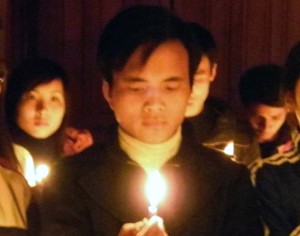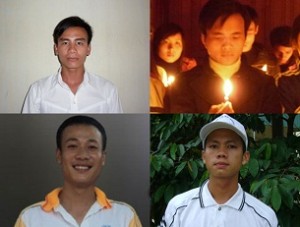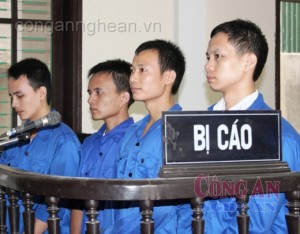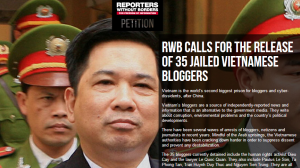The agreement that ended the hostage crisis in Dong Tam could be a model for other local governments in Vietnam.
This article analyzes the sequence of events that led to the agreement, including the significance of the commitments entered into by the government. In particular, the article highlights the role of social media in shaping public opinions. It argues that the outcome of this dispute is largely the result of the joint determination of the Dong Tam people in their fight for justice combined with support from human rights, political activists and independent bloggers, as well as the goodwill shown by Hanoi Mayor Nguyen Duc Chung. Finally, the article considers the likely impact of these events on the resolution of future land and environmental disputes.
Establishing the facts leading to the hostage crisis
The Dong Tam land dispute is characteristic of contemporary disputes that involve State repossession of agricultural land for development, the use of police to evict farmers, as well as allegations of corrupt government officials. In the Dong Tam case, the dispute began in 2014 when the defense ministry allocated 6.8 hectares of agricultural land to a communication firm, the Viettel Group. There are competing versions regarding the intended use of the land. While the local authorities stated it was for a defence project, the local people alleged state officials had misappropriated the land for private purposes and had engaged in obstructive behaviors to prevent the agricultural land being allocated to the people. On April 15, as local police arrested four protesters in Dong Tam, hundreds of people in turn detained 38 police officers. A standoff had begun and the battle to control the narrative and public opinion of the dispute was launched.
The powerful role of social media in shaping narrative and public opinion
The initial response of the government was hostile. The district government cut the electricity and internet connections of the commune. Early reports on state media portrayed the Dong Tam people negatively and demonstrated a strong, negative response from the government.
For example, a report on the April 18 by the leading State newspaper Tien Phong (‘Pioneer’) labelled the protesters as “extremists” who were breaching criminal and public order laws. The article cited statements from the Hanoi municipal government that the four people were arrested on the grounds of “disrupting social order.” It condemned the actions of the people in destroying state property and detaining the police officials in contravention of the law.
Increasingly, the use of criminal and public order laws appear to be favored by local governments in their struggle to control civil unrest. This heavy-handed treatment had assisted the government in establishing the dominant narrative of the dispute in the past. However, the Dong Tam people were determined not to succumb to the government’s oppressive treatment until their concerns were genuinely addressed. With the support of human rights advocates, political activists, international news media and independent bloggers and by utilizing Facebook, YouTube, and similar social media means, the Dong Tam people conveyed a different story about the incident from that presented in the state’s narrative.
As a result, the case attracted a substantial amount of public attention, leading to broad public sentiment towards the Dong Tam people. Following these developments, the state’s strong, negative responses began to shift. The first shift was evident when some National Assembly (NA) delegates, retired officials and state-controlled newspapers also doubted the use of an aggressive/oppressive approach, which positioned villagers against the state. Leading NA delegate Nguyen Si Dung stated “I do not believe the Dong Tam people are an enemy of the State.” He made the statement on his personal Facebook account. These developments, as well as the determination of Dong Tam people, as shown by their detention of state officials, created pressure and drove the authorities to negotiate with the people.
The outcome of negotiation and likely impact
The negotiation was headed by Hanoi mayor Nguyen Duc Chung. Chung was appointed to his current job in December 2015. He has a background as a major general and was the recipient of various state medals. After making contact with the people by phone, Chung won over the people of Dong Tam in a meeting with a promise that the state would not launch an attack on the commune to rescue the police officers. In addition, Chung announced an order to investigate the state’s land use in Dong Tam with a report to be submitted in 45 days. The conciliatory nature of Chung impressed the people and at 2.40 pm Vietnamese time on April 22 an agreement that ended the week long standoff was signed by Chung and a representative of the Dong Tam people.
In the agreement, Chung, on behalf of the municipal government made three commitments. First, he would not file criminal charges against the Dong Tam people. This is significant as in the past, criminal charges have followed after the end of violent land disputes. Second, Chung would investigate the management and the land use in the Dong Tam area. Finally, Chung would investigate the police treatment of a protester who suffered an injury during the dispute.
A number of implications can be drawn from the dramatic developments that occurred during the last few days and their likely impact.
First, the detention of police officials has demonstrated Vietnamese land protesters are increasingly prepared to confront the state to protect what they regard as their land. In turn, this willingness for direct action has made the problem of enforcing socialist laws much more difficult for the government.
Second, social media is undoubtedly weakening the government’s ability to control the narrative and public opinion. Indeed, this was evident in the change from an oppressive approach to a softer, more conciliatory, response from the state.
Third, it is too early to tell whether the agreement reached in Dong Tam was a tactical move by the state to avoid broad civil unrest or whether these events signal a genuine commitment by the state to listen and honor the wishes of the people for real land tenure rights.
Fourth, the agreement has not addressed the underlying causes of the dispute. These include the unlimited opportunities for state officials to misappropriate land in a non-transparent manner, the recognition and the legal enforcement of people’s land use rights and the payment of fair compensation for state’s land acquisition.
Despite these shortcomings, the agreement that was reached in Dong Tam could be a model for other local governments in Vietnam and in neighboring socialist states to study to resolve similar types of land and environmental disputes.
Toan Le is a lecturer in the Monash Business School, at Monash University in Australia. He has written extensively on constitutional and land tenure reforms in Vietnam.
Height Insoles: Hi, I do believe this is an excellent site. I stumbledupon …
http://fishinglovers.net: Appreciate you sharing, great post.Thanks Again. Keep writi…
Achilles Pain causes: Every weekend i used to pay a quick visit this site, as i w…






April 26, 2017
Lessons Learned From Vietnam’s Dong Tam Standoff
by Nhan Quyen • [Human Rights]
The agreement that ended the hostage crisis in Dong Tam could be a model for other local governments in Vietnam.
This article analyzes the sequence of events that led to the agreement, including the significance of the commitments entered into by the government. In particular, the article highlights the role of social media in shaping public opinions. It argues that the outcome of this dispute is largely the result of the joint determination of the Dong Tam people in their fight for justice combined with support from human rights, political activists and independent bloggers, as well as the goodwill shown by Hanoi Mayor Nguyen Duc Chung. Finally, the article considers the likely impact of these events on the resolution of future land and environmental disputes.
Establishing the facts leading to the hostage crisis
The Dong Tam land dispute is characteristic of contemporary disputes that involve State repossession of agricultural land for development, the use of police to evict farmers, as well as allegations of corrupt government officials. In the Dong Tam case, the dispute began in 2014 when the defense ministry allocated 6.8 hectares of agricultural land to a communication firm, the Viettel Group. There are competing versions regarding the intended use of the land. While the local authorities stated it was for a defence project, the local people alleged state officials had misappropriated the land for private purposes and had engaged in obstructive behaviors to prevent the agricultural land being allocated to the people. On April 15, as local police arrested four protesters in Dong Tam, hundreds of people in turn detained 38 police officers. A standoff had begun and the battle to control the narrative and public opinion of the dispute was launched.
The powerful role of social media in shaping narrative and public opinion
The initial response of the government was hostile. The district government cut the electricity and internet connections of the commune. Early reports on state media portrayed the Dong Tam people negatively and demonstrated a strong, negative response from the government.
For example, a report on the April 18 by the leading State newspaper Tien Phong (‘Pioneer’) labelled the protesters as “extremists” who were breaching criminal and public order laws. The article cited statements from the Hanoi municipal government that the four people were arrested on the grounds of “disrupting social order.” It condemned the actions of the people in destroying state property and detaining the police officials in contravention of the law.
Increasingly, the use of criminal and public order laws appear to be favored by local governments in their struggle to control civil unrest. This heavy-handed treatment had assisted the government in establishing the dominant narrative of the dispute in the past. However, the Dong Tam people were determined not to succumb to the government’s oppressive treatment until their concerns were genuinely addressed. With the support of human rights advocates, political activists, international news media and independent bloggers and by utilizing Facebook, YouTube, and similar social media means, the Dong Tam people conveyed a different story about the incident from that presented in the state’s narrative.
As a result, the case attracted a substantial amount of public attention, leading to broad public sentiment towards the Dong Tam people. Following these developments, the state’s strong, negative responses began to shift. The first shift was evident when some National Assembly (NA) delegates, retired officials and state-controlled newspapers also doubted the use of an aggressive/oppressive approach, which positioned villagers against the state. Leading NA delegate Nguyen Si Dung stated “I do not believe the Dong Tam people are an enemy of the State.” He made the statement on his personal Facebook account. These developments, as well as the determination of Dong Tam people, as shown by their detention of state officials, created pressure and drove the authorities to negotiate with the people.
The outcome of negotiation and likely impact
The negotiation was headed by Hanoi mayor Nguyen Duc Chung. Chung was appointed to his current job in December 2015. He has a background as a major general and was the recipient of various state medals. After making contact with the people by phone, Chung won over the people of Dong Tam in a meeting with a promise that the state would not launch an attack on the commune to rescue the police officers. In addition, Chung announced an order to investigate the state’s land use in Dong Tam with a report to be submitted in 45 days. The conciliatory nature of Chung impressed the people and at 2.40 pm Vietnamese time on April 22 an agreement that ended the week long standoff was signed by Chung and a representative of the Dong Tam people.
In the agreement, Chung, on behalf of the municipal government made three commitments. First, he would not file criminal charges against the Dong Tam people. This is significant as in the past, criminal charges have followed after the end of violent land disputes. Second, Chung would investigate the management and the land use in the Dong Tam area. Finally, Chung would investigate the police treatment of a protester who suffered an injury during the dispute.
A number of implications can be drawn from the dramatic developments that occurred during the last few days and their likely impact.
First, the detention of police officials has demonstrated Vietnamese land protesters are increasingly prepared to confront the state to protect what they regard as their land. In turn, this willingness for direct action has made the problem of enforcing socialist laws much more difficult for the government.
Second, social media is undoubtedly weakening the government’s ability to control the narrative and public opinion. Indeed, this was evident in the change from an oppressive approach to a softer, more conciliatory, response from the state.
Third, it is too early to tell whether the agreement reached in Dong Tam was a tactical move by the state to avoid broad civil unrest or whether these events signal a genuine commitment by the state to listen and honor the wishes of the people for real land tenure rights.
Fourth, the agreement has not addressed the underlying causes of the dispute. These include the unlimited opportunities for state officials to misappropriate land in a non-transparent manner, the recognition and the legal enforcement of people’s land use rights and the payment of fair compensation for state’s land acquisition.
Despite these shortcomings, the agreement that was reached in Dong Tam could be a model for other local governments in Vietnam and in neighboring socialist states to study to resolve similar types of land and environmental disputes.
Toan Le is a lecturer in the Monash Business School, at Monash University in Australia. He has written extensively on constitutional and land tenure reforms in Vietnam.